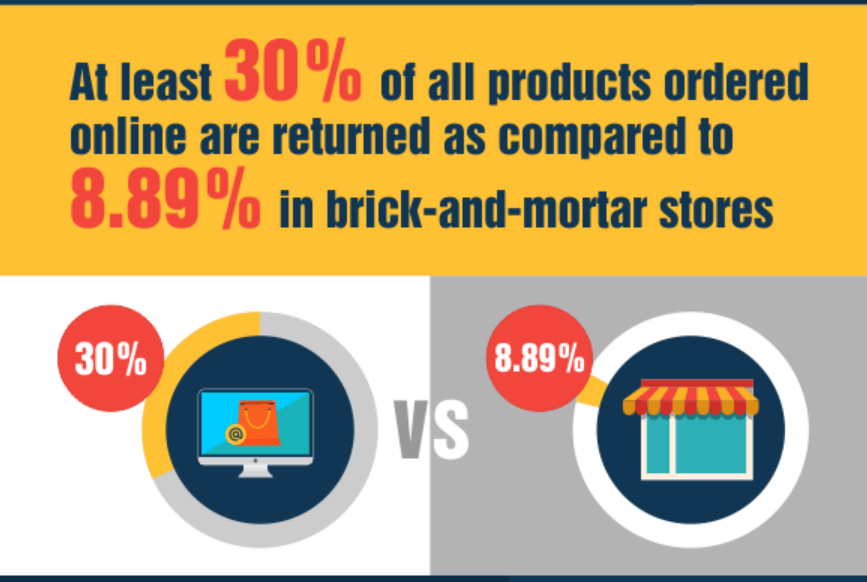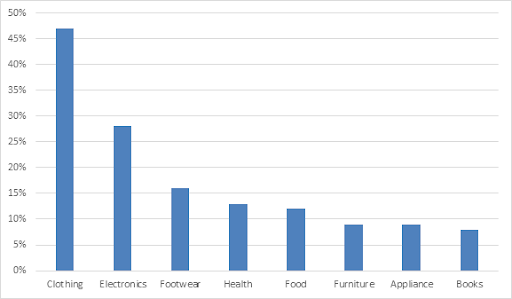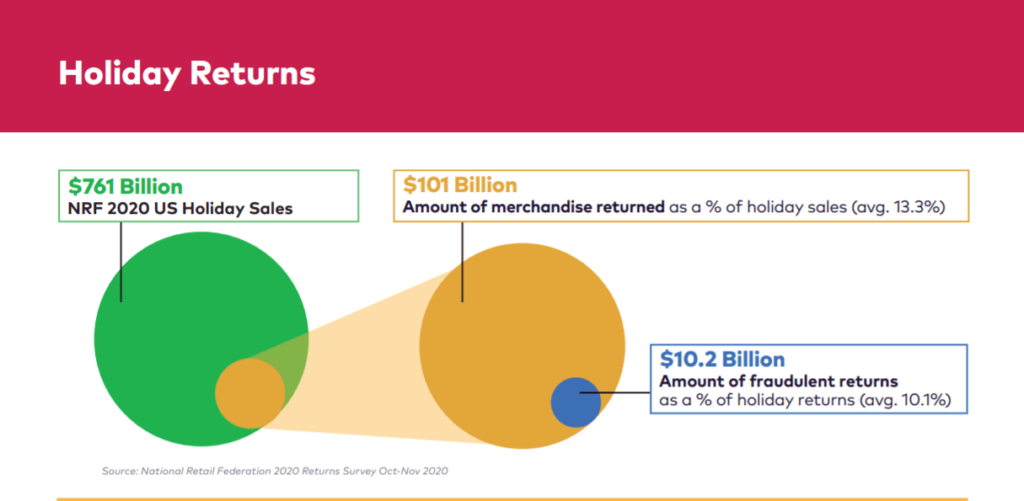Customer satisfaction is the core of all ecommerce success. And customers love an easy and flexible return policy which can lead to a high return rate. For this reason, ecommerce businesses and stores provide simple return options to increase their sales. This attracts customers and boosts our sales. At the same time, ecommerce returns also consume profit margins and lower ROI on overall customer acquisition costs, which can make businesses worry.
However, to compete in e-commerce, companies must cope with the impact of returns by finding the right mix between customer satisfaction and downside protection for the business.
What Is an Ecommerce Return Rate and How to Calculate It?
Ecommerce websites give their customers an option to return the goods purchased by them if they are not satisfied with it. While there are different return policies, free 30 day ecommerce returns with no questions asked is a popular one. To decide your return policy as an ecommerce store, you need to make sure you’re able to match with both your competitors as well as your customer demands. The key metric you need to stay on top of is your return rate. Your return rate is the number of people who return a product or multiple products from their order from every 100 orders.
So, if 5 of every 100 orders get returned, your ecommerce store’s return rate is 5%.
A business can usually do this calculation during a defined period.
Say you sold 2000 units in three months and 600 of them are returned, then the return rate for this specific period would be calculated as:
600/2000 *100 = 30%
You should define a period for recalculating return rates based on your customer cohorts. Ideally, recalculate return rates for each new cohort.
The e-commerce return rate is the frequency of items that customers return to our websites. This is very common with physical products where size may not be clear with pictures or videos. Although a reasonable product description is mentioned on websites, this uncertainty is the primary reason for sales return.
The return rate for e-commerce helps businesses to assess their performance concerning their sales targets.
Ecommerce return rates have an impact on some other metrics that businesses should take into concern. Conversion rate is one of the metrics that reflects the effect of return. Ideally, you should be looking at and measuring both conversion rates and return rates together.
While a high conversion rate is always considered good, it’s important to see if the high conversion rate comes at a cost of higher return rates too.
For example, if you have a 5% return rate at a 1% conversion rate but you find that when you change your marketing strategy, it boosts the conversion rate to 1.5% but the return rate shoots up to 15%, then there is something to be concerned about your new marketing assets.
Review your ad copy, product descriptions, and make sure you’re able to provide an accurate picture of the product.
Bonus Reading: Complete Guide to Ecommerce Conversion Rates
There is another critical metric to measure our e-commerce performance which is the gross margin rate.
Benchmarks For Ecommerce Returns

Ecommerce return rates are higher than purchases made from physical stores. This happens as the customer doesn’t check the texture or quality of the product via online shopping and gets disappointed if the product doesn’t meet their expectation. This fact leads to an increased e-commerce return rate.
Different products have different return rates under their use and their importance for the customer. For example, clothing is all about fashion and self-esteem-related products.
Customers do not compromise if their desired product does not meet their expectations, so, for this reason, dress has the highest return rate in e-commerce.
On the other hand, books or related things are something that people usually do not return, so these products have the least return rate in e-commerce.
This difference in return rates of a different product creates some benchmarks for the owners of e-commerce to assess their performance concerning their related product.
According to a survey, clothing has around a 45% return rate in e-commerce, alarming for businesses.
Similarly, different products have different benchmarks like electronics have 26%, footwear has 16%, health-related products have 13%, home appliances, furniture/fixtures, and other related products have 10-15%, books have 7%, and so on. So, these rates show that return rates in e-commerce are apparent and are part of the game.

Now let’s see the reason behind initiating the e-commerce return rate.
Most of the time, the reason behind the return of clothing is size. The product customer does not fit their body, or maybe it happened due to the wrong product description.
Sometimes, the color and design we see on screen do not match the actual color or design, which makes the customer dissatisfied and leads him to return the product.
This is usually why bags have a lower return rate than garments.
However, the product may be damaged leading to returns. This could be because of mishandling of products during shipment or delivery.
The time-lapse in delivery could be the reason for increased ecommerce return rate as if someone wants a certain product for some special day.
That product arrives after that special occasion, and then, in this case, the customer has nothing to do with that product but to return it.
Holidays periods have a dramatic effect on increased return rates in e-commerce. People are in shopping mode during the holidays and often make those impulse buying decisions.
We’ve all been there!
The return rate during the holiday season reaches 13.3% as compared to regular shopping days. Due to such seasonal peaks, we can see a significant increase in return activity.

Best Practices to Reduce Ecommerce Return Rates

As we know, we can’t eliminate the ecommerce return rate, but we can reduce it with some practice.
1. By Displaying A Prominent Return Policy
If the customer is sure that the product can be returned if he doesn’t like it, then this creates a sense of satisfaction in his mind, increasing the chance that the customer might accept the product.
2. True Product Description
If we make a false description of the product, then it will increase the chance of return. So, make an accurate and fair statement in the product description.
3. HD Images Of the Product
A high-definition image of the product clarifies the quality of the product that will reduce the chance of ecommerce returns.
4. Augmented Reality Technology
AR technology will allow the customer to check the product from different angles and perspectives, which helps to make an accurate image of a product in the customer’s mind and reduce the ecommerce return rate.
5. Careful Delivery
Practice preventive measures to make shipment and delivery safe so the product does not get damaged and satisfy customers.
Reduce Ecommerce Return Rates with The Following Tips
1. Providing Sizing Chart
When a customer has a complete size chart, he will order according to his need and not return the product when the suit fits him.
2. Provide An Alternative Option At The Time Of Return
By doing so, the customer may make up his mind to buy that alternative product rather than buying nothing.
3. Creating Brand Image
Once you create your goodwill, it is most probable that customers will be satisfied with your product and not return it.
4. Finding The Reasons For Return
Once you find the reason for the return, then you can reduce the ecommerce return rate.
5. Allow Size Exchange Using Software
If the customer wants to stop returning because of size, if he can exchange with his desire size, he will exchange rather than return.
6. Provide High-Quality Products
When you provide a high-quality product, then it is less likely to get returned.
7. Set The Time Limit For Return
Setting a limit reduces the ecommerce return rate as most customers could not return it on the due date.
8. Don’t Let The Deal End.
If the customer wants to stop returning the goods, try to influence him to get another article of a different size or color.
9. Give Better Product Than A Competitor
Your product should be unique and different from competitors, making the customer not return it for its uniqueness.
10. Allow Returns Only In Stores
Most of the customers will not visit stores, and it could be helpful to reduce the return rate of your ecommerce store.
Those are some of the ways to reduce ecommerce returns and to keep the ecommerce return rate under control.
Bonus tip: You can also explore return shopping options by apps such as Happy Returns. There are many good apps to manage returns if you’re using Shopify to build your ecommerce store.


